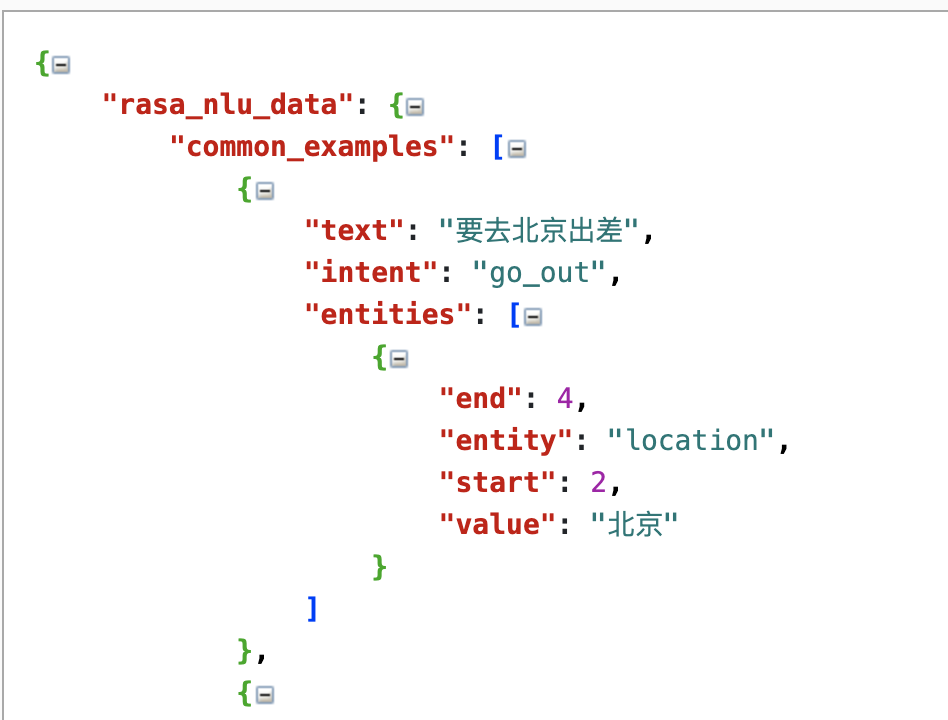NLP训练数据生成之chatito
巧妇难为无米之炊,NLP任务也需好的数据来作为支撑。这里就有两个方面:
- 完全没有数据
- 有大量未标注脏数据,标注极少甚至没有
这个问题我打算用几篇博客一一讨论,本篇针对完全没数据的场景,介绍使用chatito来生成数据。
Chatito简介
Chatito使用简单易上手的DSL语法来为几类场景的NLP任务生成数据。原话是
Generate datasets for AI chatbots, NLP tasks, named entity recognition or text classification models using a simple DSL!
亲测确实方便生成一定量的数据,但是生成的训练集和测试集都是一个模板(构成规则)出来的,训练测试数据同源同构,很容易造成严重的过拟合。典型的表现是在测试集上的准确率和F1等指标会接近1,在未知数据上的泛化性会不好。
显然,采用这种方式生成数据并不是最好的方式。但在实在没有数据的情况下,怎样去解决同源的问题呢?想到的解决方式有几点:
- 生成的过程中,只填入几条典型的场景,同类型的采用词典,并后续任务上构造词典特征
- 生成后采用一些数据增强方式(同义词替换、位置交换等),增加训练数据的多样性。
本文不具体介绍这两种方式,会另外用实际的例子和博客分别进行记录,包括本文的例子都放在repo: DataGeneratorForNLP
使用前准备
安装node.js
首先需安装node.js >= v8.11
- 官网下载编译好的包
- 解压
- 设置软连接
ln -s /usr/software/nodejs/bin/npm /usr/local/bin/
ln -s /usr/software/nodejs/bin/node /usr/local/bin/在mac上直接采用homebrew安装即可
brew install node
brew install npmnpm配置
npm config set registry https://registry.npm.taobao.org --global
npm config set disturl https://npm.taobao.org/dist --global
# 更新
npm install -g npm安装chatito npm package
npm i chatito --save编写构成脚本
因为一个脚本只能生成一个类型的,比如在分类问题中要生成多个类的数据,最好一个类一个生成文件。所以,最好新建一个文件夹,存放所有脚本,比如chatito
下面以对话中介绍新朋友这样一个场景为例,介绍脚本的写法,完整的语法参见DSL。
新建一个以.chatito结尾文件,命名为intro_new_user.chatito,内容为:
import ./common.chatito
%[intro_new_user]('training': '100', 'testing': '50')
*[60%] ~[hi?],~[pre1?]~[pre2]~[pre3],~[indicate?]@[username]
*[20%] ~[hi?],~[indicate]@[username]
*[20%] ~[indicate]@[username]
~[pre1]
给你
~[pre2]
介绍
认识
了解
~[pre3]
一个新朋友
一位新朋友
个新朋友
位新朋友
一个朋友
一位朋友
个朋友
位朋友
一下
下
~[indicate]
这是
他是
她是
他叫
她叫
我是
我叫
@[username]
小红
小花
大黄
小明其中common.chatito为另外一个提供通用组成部分的脚本,内容为
~[hi]
你好
嗨
嘿
哈喽
hi
hello
~[please]
请
~[thanks]
谢谢
谢了
thx
谢谢你比如hi,import后就可以采用~[hi]直接引用了。
因为chatito初衷是给对话生成数据,所以脚本里的概念有三个:意图(%[intent_name])、槽值(@[slot_name])和别称(~[alias_name])。意图可以视为分类问题的类别,槽值可视为NER问题的实体,别称只是为了方便组合,随机选取,有点像正则的里中括号里的内容(如[a-zA-Z])。p.s. 别称里的内容不会被认为是实体。
在上面的例子中%[intro_new_user]('training': '100', 'testing': '50'),表明想生成的意图是intro_new_user。并且训练集生成100个样本,测试集50个。
接下来的一行, *[60%] ~[hi?],~[pre1?]~[pre2]~[pre3],~[indicate?]@[username]
*[60%]: 表示这一行的构成规则在最好生成数据中占的比例~[hi?]:随机选择别称hi的一个(比如,选择你好),?表示可以不选,这个与正则中的概念相似@[username]:随机选取槽username中的一个,在生成的数据中,选取的槽值会被标记为实体,可用于实体识别,有位置信息。
这里需要注意的是:各个部分之间如果有空格,生成的结果中也会有空格。生成结果只是替换~[hi?],~[hi?]和其后面的~[pre1?]之间的任何内容都会原封不动保留,比如这里的逗号。所以,对于要考虑分词的误差的场景下,建议各个部分之间不要采用空格分隔的方式,保持中文的自然连接。
基本这些内容就够用了,其他用法可以自行探索DSL。
生成数据
生成语法为
npx chatito <pathToFileOrDirectory> --format=<format> --formatOptions=<formatOptions> --outputPath=<outputPath> --trainingFileName=<trainingFileName> --testingFileName=<testingFileName> --defaultDistribution=<defaultDistribution> --autoAliases=<autoAliases><pathToFileOrDirectory>path to a.chatitofile or a directory that contains chatito files. If it is a directory, will search recursively for all*.chatitofiles inside and use them to generate the dataset. e.g.:lightsChange.chatitoor./chatitoFilesFolder<format>Optional.default,rasa,luis,flairorsnips.<formatOptions>Optional. Path to a .json file that each adapter optionally can use<outputPath>Optional. The directory where to save the generated datasets. Uses the current directory as default.<trainingFileName>Optional. The name of the generated training dataset file. Do not forget to add a .json extension at the end. Uses ``_dataset_training.json as default file name.<testingFileName>Optional. The name of the generated testing dataset file. Do not forget to add a .json extension at the end. Uses ``_dataset_testing.json as default file name.<defaultDistribution>Optional. The default frequency distribution if not defined at the entity level. Defaults toregularand can be set toeven.<autoAliases>Optional. The generaor behavior when finding an undefined alias. Valid opions areallow,warn,restrict. Defauls to ‘allow’.
可以生成Rasa、Flair、LUIS、Snips NLU格式的数据,以Rasa为例。
npx chatito ./chatito --format=rasa --outputPath=./data生成的结果放在data文件夹下
rasa_dataset_testing.json
rasa_dataset_training.json生成的文件是一行的json,采用pbcopy < rasa_dataset_testing.json, 粘贴在http://www.totootool.com/json.html。

训练集会多两项
"regex_features":[],"entity_synonyms":[]具体跟rasa有关,这里不再赘述。
接下来,会介绍如何使用snorkel做NLP数据增强和弱监督训练数据生成。
本博客所有文章除特别声明外,均采用 CC BY-SA 4.0 协议 ,转载请注明出处!